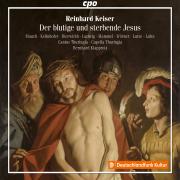Texte paru dans: / Appeared in: CPO5552592 |
|
|
Reviewer: James
A. Altena
For many classical music
lovers, the name Reinhard Keiser (1674–1739) is familiar, if known at all,
only as the composer of a St. Mark Passion that Bach regularly had performed
at Leipzig, and from which some musicologists accordingly have borrowed the
recitatives in reconstructing Bach’s own lost passion of the same name. (As
a boy, Keiser was educated at the Leipzig Thomasschule.) Yet in his day
Keiser was one of Europe’s most famous and esteemed opera composers, penning
well over 50 such works (about 25 of which survive), and heading the famed
Gänsemarkt theater in Hamburg for 20 years from 1697 to 1717. In 1728 he
succeeded Johann Mattheson as cantor of the Hamburg cathedral church, after
which he abandoned opera and devoted himself to sacred music until his
death.
(Unfortunately only a few
fragments survive of the works from this last period.) His music exercised a
significant influence upon both Handel and Hasse. The decline in his
reputation was due in part to changing taste (his friend Telemann would
supersede him in popularity) and in part due to his dissolute lifestyle (he
was frequently and deeply in debt). In modern times occasional revivals of
his operatic masterpiece Croesus have brought him a small degree of renewed
attention. Yet, whenever Fanfare critics—Barry Brenesal, David Johnson,
Brian Robins, Ron Salemi, Bertil van Boer, J. F. Weber—have encountered
Keiser’s music, whether sacred or secular, there have been delighted
exclamations over its high quality, particularly its melodic inspiration and
inventiveness in instrumentation.
To that chorus of critical
praise I now wish to add my own voice. Der blutige und sterbende Jesus (The
bloody and dying Jesus) from 1705, a passion oratorio penned for use in Holy
Week, is Keiser’s earliest surviving sacred work. The libretto’s author was
Christian Friedrich Hunold (1680–1721), a writer in various genres under the
nom de plume of “Menantes” who was a frequent collaborator with Keiser, and
who apparently shared a similarly disreputable lifestyle. A scandal (perhaps
deliberately courted) was occasioned at the 1705 premiere; despite a
city-wide ban on stage performances during Lent, Keiser presented the work
with a full-fledged dramatic staging in church, and with use of female
singers from the opera house adding to the controversy. The version offered
here is a revision from 1729; the manuscript, discovered in Berlin in 2006
by musicologist and booklet notes author Christine Blanken, is the only
known autograph score of a sacred work by Keiser. (His other extant sacred
works come from 18th-century printed editions.)
The score is a masterpiece
that ranks in quality just a step below the comparable works of Bach and
Handel, and alongside many of those by Telemann. To the aforementioned
traits of melodic inspiration and inventive instrumentation, one can add
unfailing lightness and gracefulness of touch, and the keen sense of mood
and dramatic contrast that one would expect from a master opera composer.
The scoring here—for strings (first and second violins, viola, cello, and
violone); pairs of flutes, recorders, and oboes; bassoon, harpsichord, and
organ—is used with great color and variety in the instrumental pairings,
including many brief solo parts. The solo vocal parts are in turn generously
and almost evenly distributed between two Daughters of Zion (soprano and
alto), Maria (soprano), Peter and Judas (tenors), Jesus, Caiaphas, and
Pilate (basses); there are also the usual comprimario roles for maids,
soldiers, and servants. The arias are mostly short in length—only one lasts
significantly longer than four minutes—though on several occasions a
sequence of alternating recitatives and arias results in a single character
singing continuously for about 10 minutes. Each of the two sections of the
oratorio opens and closes, as was traditional, with a short congregational
chorale; those and the occasional choruses for the soldiers and people are
likewise brief. All the soloists except for Dominik Wörner as Jesus are drawn from the ranks of the Cantus Thuringia and sing in the chorales and choruses as well. They are all quite good, although I have reservations about Wörner; his voice sounds remarkably like that of Klaus Mertens in the early phases of the latter’s ongoing vocal decline, with a certain dryness and hardness of tone. Bernhard Klapprott conducts ably, and his instrumental and choral forces perform with precision and vigor. Everything is well recorded, and CPO as usual provides a detailed bilingual German-English booklet with full texts. This is an unexpectedly treasurable find, which lovers of Baroque sacred music should add to their collections forthwith; strongly recommended.
| |
|
|
|
|
|
|
|
Cliquez l'un ou l'autre
bouton pour découvrir bien d'autres critiques de CD |
|




